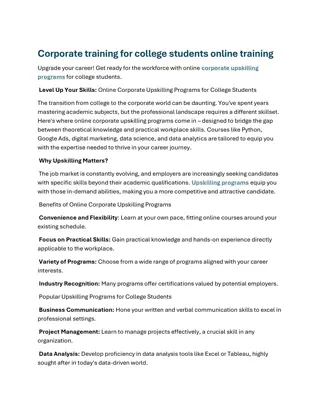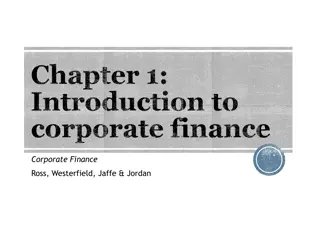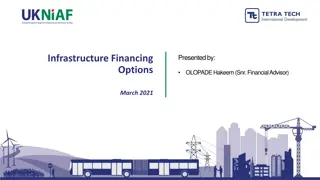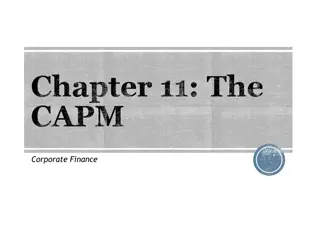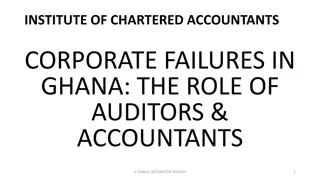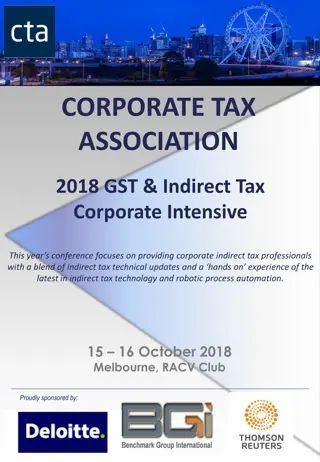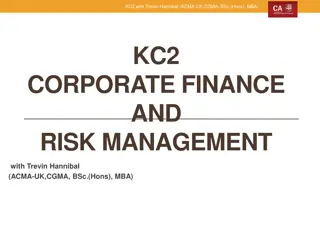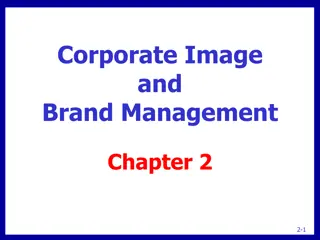Understanding Corporate Finance Strategies with Trevin Hannibal
Delve into the world of corporate finance with Trevin Hannibal, exploring the role of the treasury department, evaluating corporate objectives, and advising on financial strategies. Discover insights on overtrading, objective evaluation, and recommendation techniques in the finance realm.
Download Presentation

Please find below an Image/Link to download the presentation.
The content on the website is provided AS IS for your information and personal use only. It may not be sold, licensed, or shared on other websites without obtaining consent from the author. Download presentation by click this link. If you encounter any issues during the download, it is possible that the publisher has removed the file from their server.
E N D
Presentation Transcript
KC2 CORPORATE FINANCE With Trevin Hannibal (CIMA Passed Finalist ,Pg.Dip in BA, MBA Cardiff Metropolitan University)
Scheme of Work Question based theory discussions Analysis of questions Advice on answer planning Discussion of model questions
Question 1- Requirement a) Discuss the role of the treasury department when determining financing or refinancing strategies in the context of the economic environment described in the scenario Explain how these might impact on the determination of corporate objectives.
Answer plan Introduction sentence - economic environment Inflation zero, fall in interest rate On financing a re-financing options to the treasury department What is the current situation at CD Can they increase debt ?if so the implications Can they increase equity? if so the implications Implications to the corporate objectives Can we re-finance? if so implications What will happen to share holders wealth
Question 1- Requirement b) Evaluate the appropriateness of CD's current objective and of the two new objectives being considered. Discuss alternative objectives that might be appropriate for CD Conclude with a recommendation.
Answer plan Evaluation of the current objective- increase divided Benefits of the current objective Drawbacks Proposed objectives Shareholder wealth max? implications Increasing PAT and ROI? Implications Recommendation Highlight the issues on the proposed objectives Suggest balance score card
Question 2 Requirement Prepare a report to the Finance Director of MAT advising on whether the entity could be classified as overtrading Recommending financial strategies that could be used to address the situation. Points to consider Recommendations should be based on analysis of the forecast financial position making whatever assumptions that are necessary Should include brief reference to any additional information that would be useful to MAT at this time
Relevant ratio to be calculated Increase in sales Increase in cost of goods sold Increase in profit margin Current ratio Quick ratio Sales to net current assets Inventory to revenue Debt Ratio : Debt Equity Gearing Debt : Debt + Equity Days accounts receivable Days accounts payable Days inventory Capital turnover Revenue: Non-current assets
Answer plan Report format Introduction Purpose Sections of the report Discussion of the calculations as symptoms of overtrading; Advice on financial strategies; Other information
Symptoms of over-trading There is a fall in liquidity, as measured here by the current ratio=2 83 to 1 55. The sales to net-current assets ratio will rise from 5 5 to 10 indicating a potential overtrading situation. There is expected to be a sharp rise in receivables as measured by days outstanding. Last year, on average, debtors were 44 6 days. The forecast is 60 3 days either a change in collection policy an expectation that sales will be extended to customers with poorer credit or payment history A dramatic increase in WC Cycle is not to be seen.
Symptoms of over-trading MAT is demonstrating some signs of overtrading (current ratio and the ratio of sales to net current assets and days accounts receivable) The entity is forecasting an increase in its non-current assets but no increase in long term debt. This suggests these purchases are likely to be financed by overdraft Overtrading can have serious consequences for any organization; liquidity problems can result in bankruptcy or financial distress.
Financial strategies Use more trade credit Reduce credit to customers Consider invoicing customers in their own currency More aggressive debt collection
Additional information Breakdown of inventory into raw materials, WIP and finished goods; Cash flow forecast by month; Details of the non-current assets purchases and depreciation policy; Information on level of bad debts incurred and expected.
Questions-3 a) Construct a forecast income statement, including dividends and retentions for the years ended 31 December 2016 and 2017. b) Section b) Construct a cash flow forecast for each of the years 2016 and 2017 Discuss, briefly, how the company might finance any cash deficit.
Financing the cash deficit There is need to finance a cash shortfall of 1,680,000 by the end of 2016. As the shortfall is caused by the purchase of new assets, there should be no problem increasing the overdraft limit given the size of the entity. It could be argued that as these are long term assets they should be funded by long-term finance but the amount is relatively small compared to the value of the entity.
Requirement c) Using your results in (a) and (b) above, Evaluate whether EF is likely to meet its stated objectives. EVALUATE As part of your evaluation, discuss whether the assumption regarding overdraft interest is reasonable Explain how a more accurate calculation of overdraft interest could be obtained.
Requirement c)- answer plan Return on shareholders funds: Achieved in 2015 and unsuccessful in 2016 and 2017 The new assets might begin to contribute to an improvement but they are clearly replacement assets for an existing facility and as such are unlikely to have a significant impact. Increasing's earnings? The increase in earnings is well below EF s target for 2016 and 2017 but is moving in the right direction.
OD interest The removal of the simplifying assumption regarding overdraft interest can be expected to have a significant effect on forecast cash flows after tax. the increase in earnings that is observed above is so small that an increase in overdraft interest in 2016 could reduce earnings to the point at which earnings actually decline in 2016 from 2015 levels. Recommended to calculate an Average OD interest based on average cash balances.
Question 4 (a) Calculate which payment method is expected to be cheaper for AB and recommend which should be chosen based solely on the present value of the two alternatives as at 1 January 2016 Explain the reasons for your choice of discount factor in the present value calculations. Discuss other factors that AB should consider before deciding on the method of financing the acquisition of the system
a ii) discount rate The discount rate that should be used in financing decisions is the opportunity cost. Finance leases are considered a direct substitute for borrowing, the opportunity cost of leasing is the after-tax cost of borrowing
a iii) other factors to consider Consideration must be given as to how or when the borrowings are to be repaid if alternative 1 is chosen. Tax benefits appear to have a significant influence on the decision; a sensitivity analysis should be carried out to determine the impact on the decision if tax rates or regulations change.
b) Advise the Directors of AB on the following: The main purpose and content of a post completion audit (PCA). The limitations of a PCA to AB in the context of the POS system.
Answer plan for b) Importance of PCA It enables a check to be made on whether the performance of the system corresponds with the expected results. It generates information, which allows an appraisal to be made of the managers who took the decision to upgrade the system. It can provide for better project planning in the future. Limitation if PCA Sufficient resources are often not allocated They can be time consuming They are sometimes seen as tools for apportioning blame,
Q5 Requirement a) Calculate and recommend which payment method is expected to be cheaper for BEN in NPV terms. b) Evaluate the benefits that might result from the introduction of the new TMS. Include in your evaluation some reference to the control factors that need to be considered during the implementation stage.
Answer plan for b) Benefits of TMS The primary benefit is that one integrated system will replace a number of apparently disparate legacy systems Greater security of data More flexibility of operations Takes advantage of technological developments. Control mechanism The PCA should provide a source of information This should improve project control and governance Enable changes to be introduced to put the project back on track in a timely manner
Requirement c) Advise the Directors of BEN on the following: The main purpose of a post-completion audit (PCA): What should be covered in a PCA of the TMS project; The importance and limitations of a PCA to BEN in the context of the TMS project.
c) With reference to BEN Purpose Project control; Improving the investment process; Assisting the assessment of performance of future projects
c) With reference to BEN What is covered It enables a check to be made on whether the performance of the TMS corresponds with the expected results It generates information, which allows an appraisal to be made of the managers who took the decision to upgrade the system It can provide for better project planning in the future
c) With reference to BEN Limitations Sufficient resources are often not allocated to the task of completing PCAs so often are not undertaken They can be time consuming and costly to complete If undertaken by the managers of the project, they may claim credit for all that went well and blame external factors for everything that didn t
Capital structure -Theory in a nutshell Calculation of Ke DVM DGM CAPM CAPM deal with Risk free Risk premium The risk premium could be categorized into Diversifiable/Firm Specific/Unsystamatic Risk Non Diversifiable/Market/Systamatic Risk
Capital structure -Theory in a nutshell Calculation of Kd If the debt is irredeemable Interest yield is considered If the debt is redeemable Yeild to maturity is considered A combination of Ke and Kd is embedded in the WACC
Calculation of project specific COC Approach 1 Calculation of beta ungeared through the beta asset formula using the proxy companies geared beta ( Removing the financial risk) Re-gear to the companies capital structure The new beta is incorporated to the CAPM formula to compute the Keg The Keg is substituted to the WACC to compute the Project specific COC
Calculation of project specific COC Approach 2 Calculation of beta ungeared through the beta asset formula using the proxy companies geared beta ( Removing the financial risk) The beta ungeared is incorporated to the CAPM formula to compute Keu. The Keu is substituted to the M&M Kadj formula to compute the Project specific COC
Question 6 a) Discuss the appropriateness of the two Directors suggestions about the discount rate when evaluating the proposed investment Recommend an appropriate rate to use. You should support your discussion and recommendation with calculations of two separate discount rates one for each Director s suggestion. Show all your workings
Answer plan a) Director A Comment on the gearing COC of 10.06 or 10.74 toward the NPV Arguments against using WACC? Proposed project is a major diversification Hence WACC does not capture the risk of the new venture Arguments against for using WACC The project is marginal, that is, it is small relative to the size of the entity Gearing doesn t change drastically
Answer plan a) Director B The theoretically correct approach Gearings are significantly different from ABC. However, the equity beta is influenced by the level of financial risk (gearing). Unless the market-weighted gearing of XYZ is the same as ABC, it is necessary to ungear the equity of XYZ. Regear to take account of ABC s financial risk: Prior or post capital structures can be used for regearing
Requirement b) Discuss how ABC s market capitalisation might change during the week the proposed investment becomes public knowledge. No calculations are required for this part of the question.
Answer plan EMH 3 forms and how the price will react if semi-strong form exists In theory, if the market agrees with ABC s figures and confidence in its ability to handle the diversification, the market capitalisation will increase by the NPV of the venture; Change in price depends on how the market receives the information major diversification could be seen as a positive or negative; Market capitalization will increase if the public perceives its successful There will be external factors that affect the price/value as well as what is happening at ABC.
Question 7- requirement a) Discuss the meaning of the terms systematic and unsystematic risk Their relationship to a company s equity beta. Include in your answer an appropriate diagram to demonstrate the difference between the two types of risk.
Answer plan a) Risk that cannot be diversified away is called systematic risk Risk that can be reduced by diversifying the securities in a portfolio is unsystematic risk. Beta is the measurement of systematic risk estimated by considering the volatility of an individual share price movement against the movement in the market as a whole An entity with an equity beta greater than 1 would be expected to have systematic risk proportionately greater than the risk of the market( vice versa)
Requirement b) Using the CAPM and the information given in the scenario about CIP and Companies A and B, calculate for each of CIP s proposed investments: An asset beta. An appropriate discount rate to be used in the evaluation of the investment
Requirement c) Evaluate The benefits Limitations Of using each of the following in CIP s appraisal of the two investments: CIP s WACC. An adjusted WACC as suggested by the Managing Director. CAPM-derived rates that use proxy (or surrogate) companies betas.
Pros and cons of the discounts rates WACC Easy to understand Theory does not support using WACC for investment appraisal Discrepancies in capital structure Adjusted WACC suffer from the same problems as the basic WACC easily understood by non-finance people CAPM-derived rates It is based on historical data Comparisons with proxy companies are difficult as they assume close similarity of activities and business risk
CAPM derived rates CAPM is a single period model, The risk of the investments could well change over their lives. It is based on historical data and the variance surrounding beta is large; using the CAPM at all can only provide a rough estimate. It also assumes that past variability with the market will continue. CAPM assumes only systematic risk needs to be captured as unsystematic risk has been diversified away. This might not be true in a single, relatively small private company with few shareholders, whereas the proxies are listed companies with, presumably, a large number of unconnected shareholders. Comparisons with proxy companies are difficult as they assume close similarity of activities and business risk. No two companies are exactly alike and even if the activities seem similar their operations could be quite different in terms of business risk.
Requirement d) Discuss, briefly, how an asset beta differs from an equity beta And why the former is more appropriate to CIP s investment decision. Include in your discussion some reference to how the use of the CAPM can assist CIP to achieve its financial objective.
Answer plan Distinguish asset and equity beta Refer to the case Use of CAPM Comparison with the current rate








